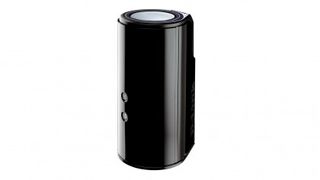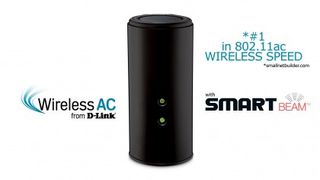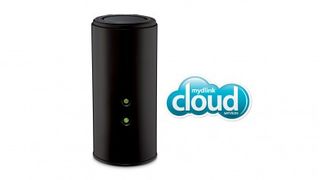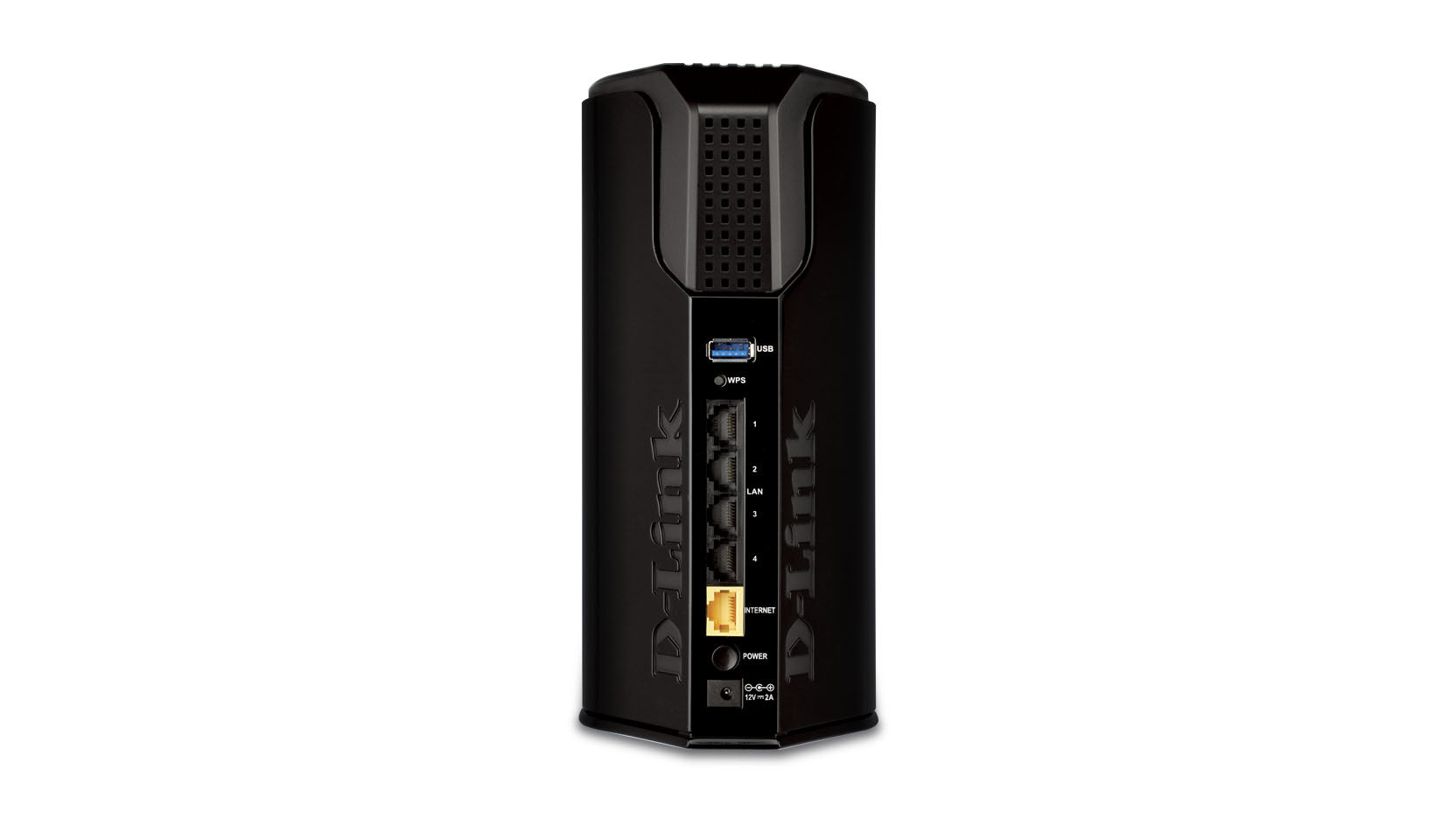TechRadar Verdict
Pros
- +
802.11ac support
- +
2.4GHz and 5GHz support
- +
Gigabit LAN ports
- +
Good 5GHz 802.11n speeds
Cons
- -
Complex web interface
- -
Slow short-range 2.4GHz speeds
- -
Single USB port
- -
Limited 802.11ac availability
Why you can trust TechRadar
Life doesn't get better than the D-Link DIR-868L, or what the brand describes as a Wireless AC1750 dual-band gigabit cloud router. That little marketing mouthful should explain what D-Link hopes to be selling in its top-of-the-line consumer wireless router.
And D-Link has quite the line in routers, offering every combination of 802.11ac and 802.11n streams adding up to those odd numbers in its model names.
This top-flight D-Link DIR-868L model is dubbed the AC1750, because it offers the current-best triple AC streams each running at 433Mbps, adding up to 1300Mbps at the 5GHz band.
Entirely independent of this you can then add three streams of 802.11n, each running at 150Mbps for another 450Mbps and that odd 1750 in total. The D-Link DIR-868L is capable of that thanks to its internal six-antenna array.
Talking of signals, part of the AC standard is a signal-focusing technique called beam forming. You'll find various manufacturers selling this as a new feature, and here D-Link is branding it Smart Beam.

D-Link also supplies a full range of 802.11ac-based routers, which offer every combination of triple, double and single streams at both the 802.11ac 5GHz and 802.11n 2.4GHz bands, so that it support 802.11a/b/g/n/ac Wi-Fi.
The D-Link DIR-868l - which costs around £195/US$195/AU$215 - has four Gigabit LAN ports plus an additional Gigabit-speed WAN port for cable users.
A single USB port offers the ability to add NAS storage or a printer, too. That's accompanied by the usual DLNA and iTunes server features, so the router can provide standard DLNA media streaming features.
As is more common now, a virtual Guest network can be activated on an either/or basis for the 2.4GHz and the 5GHz wireless networks. This provides internet access without access to the local area network, and can be further restricted via a schedule for each band.
So that the term "cloud" could be included in the name, D-Link has built a number of handy remote management tools, which include Android and iPhone apps. These are annoyingly split over three separate apps - the mydlink, SharePort and QRS Mobile.

The three combined enable you to access connected USB devices to stream and share any stored media, provide remote management of the router and installation via a mobile device rather than a computer. Otherwise all of this is installed and controlled through a standard browser interface.
We were fans of the original D-Link DIR-655 802.11n router from way back in 2007, and the more recent D-Link DIR-505, and incredibly the web interface that D-Link uses has changed little since that older model.
On the plus side it's fast and incredibly comprehensive, but for less savvy consumers the deluge of menus and options is going to be a little too much. We're surprised there's no fluffy, easy-to-use, web front-end, though perhaps D-Link is expecting such people to opt for the app-based installation.
Performance
Our expectations of 802.11ac performance have been evolving since the arrival of the first routers back in September 2012 and the poorly-performing Buffalo AirStation 1750. Even back then we weren't going to be very impressed by speeds in the 30MB/s region.
Testing of 802.11ac kit continues to be hampered by lack of full-speed adaptors, even Intel is currently only shipping a 2x2 or 867Mbps mini PCIe card for internal laptop use. To test the full 3x3 1300Mbps speed we use a second router as an Ethernet extender, which doesn't give us quite the same fidelity to tweak connection speeds, but it does at least connect at full 1300Mbps 802.11ac speeds.
Out of the box, same room 802.11ac speeds are good. The average download speed was 54.6MB/s and the upload was 42.1MB/s. These speeds run very closely to the Netgear D6300 router without requiring quite as large a chassis. Despite the results it's still far short of the Linksys EA6500 that managed 68.5MB/s and 66MB/s.

Moving to a room away, which puts a solid brick wall in the way, again saw the D-Link DIR-868L closely mirror, if with a small performance drop, the Netgear R6300. With a downstream of 47.7MB/s and upstream of 43.3MB/s, it's a good increase on most decent 450Mbps 802.11n routers. Against the Linksys EA6500 it still falls short at 60MB/s and 53MB/s.
Lastly the D-Link DIR-868L is one of the few 802.11ac routers that we've managed to run distance tests on. The results were a little mixed with a good upstream rate of 20.4MB/s but a downstream speed only half this, at 9.1MB/s.
It's possible the downstream was losing a stream, but this result was mirrored by the D-Link DWA-182 USB adaptor, so it may just be the performance of the router at range. Even so, this does show the speed capabilities of 802.11ac. It's something we've seen while testing the Netgear A6200 USB adaptor with its Netgear D6300 router.
As a standard 5GHz and 2.4GHZ 802.11n 450Mbps router, the D-Link DIR-868l puts in an acceptable performance. The only oddity is at the short, same-room test, when only a single stream could be established at 2.4GHz for basic 11.7MB/s transfer speeds.
At the 5GHz band this increased to 22MB/s in both directions, but it's hardly pack-leading. The router manages to hold its head high at the mid-range, though it's not doing anything to excel, with an average downstream of 15MB/s and 20.6MB/s upstream at 5GHz. The same again goes at distance, where a usable 7MB/s marks its up and downstream speeds.
Verdict
We're fans of the D-Link router design, though we can see the blank black tower getting the cold shoulder from certain quarters. If you want it to, it will sit anonymously enough nestled among your book collection, pumping out cutting-edge wireless signals.
It's also offering everything you'd want from that device too - a second USB port might help, but a dedicated NAS solution would avoid that and probably run faster.
We liked
As an 802.11ac router the D-Link DIR-868l does enough to make you take notice. It certainly keeps up with Netgear's fastest, and that's offering a good enough speed increase over older technology to make the investment worthwhile. Just as importantly, it does a good job at distance and mid-range Wi-Fi, with normal 802.11n bands. This means you can happily upgrade without worrying about compromising performance for any existing devices, since it's going to match or better your existing kit.
Add all of that to the desirable full range of Gigabit LAN and WAN ports, plus the now standard DLNA streaming, guest access and additional features, and there's a lot to like here.
We disliked
Our main beef with the D-Link is the inconsistent 2.4GHz performance. It had a tendency at close-range to opt for a single stream, which limits the throughput to around 11.7MB/s. There's nothing to quibble about beyond this, since mid- and long-range speeds are as good as you'd hope for from a 450Mbps router.
Otherwise we're left picking at the lack of a friendly interface for novice users, where many of the advanced features are going to be indecipherable for the layman.
Final verdict
Finally we're at a point where wireless 802.11ac is becoming a potentially usable technology with both internal and USB-based laptop adaptors now available. While the D-Link doesn't jump out as the best in its class, it's certainly up at the leading edge.
With its compact design, full range of features and Gigabit LAN ports there's little to criticise.
First reviewed 16 August 2013

ICYMI: the week's 7 biggest tech stories from Casio's smart ring watch to YouTube’s Spotify Wrapped

MIT researchers say nanoscale 3D transistors made from ultrathin semiconductor materials promise more efficient electronics; quantum mechanics offers a path beyond silicon limits

Netflix removes AI art poster for Arcane after an outcry from creators
